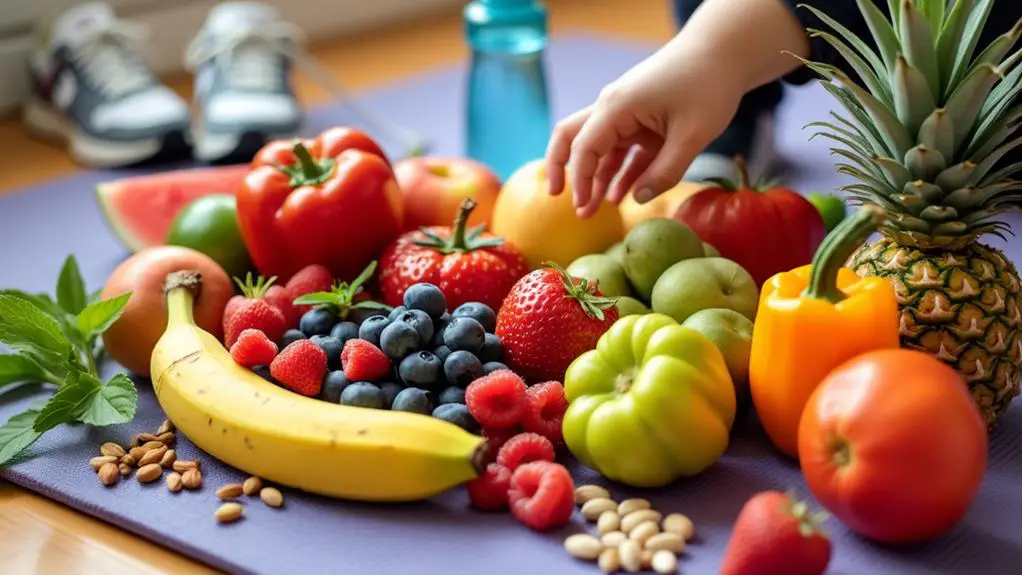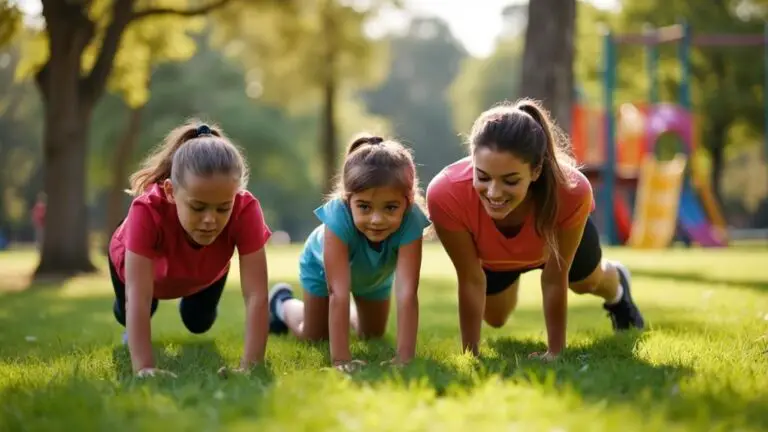Teaching Kids About the Importance of Post-Exercise Nutrition
Teaching kids about post-exercise nutrition is essential for their athletic development and overall health. You'll want to focus on the importance of replenishing energy with a balanced mix of carbohydrates and protein within 30-60 minutes after exercise. Make learning fun with activities like creating nutritious snack challenges or nutrition relay games. Introduce them to kid-friendly recovery snacks like Greek yogurt with berries or peanut butter banana toast. Don't forget to emphasize proper hydration and the concept of recovery time. By instilling these habits early, you'll set them up for better performance, reduced injury risk, and long-term health benefits. Discover more ways to make post-exercise nutrition engaging for young athletes.
Key Takeaways
- Use interactive games like the Post-Workout Snack Challenge to make learning about balanced nutrition fun and engaging.
- Explain the anabolic window concept using visual aids to help kids understand the importance of timely post-exercise eating.
- Teach the 3:1 carbohydrate to protein ratio for optimal recovery, using simple examples of balanced snacks.
- Emphasize hydration's role in recovery, encouraging kids to drink water and eat hydrating foods after exercise.
- Highlight long-term health benefits of proper post-exercise nutrition, including injury prevention and improved sports performance.
Understanding Post-Exercise Nutrition Basics
The foundation of post-exercise nutrition lies in understanding its vital importance for young athletes.
You'll want to teach kids that what they eat after exercise can make a big difference in how well they recover and perform. Emphasize the importance of timing, aiming for a post-workout meal within 30-60 minutes of finishing exercise.
This meal should include both protein and carbohydrates in a 3:1 ratio, with about 20-30 grams of protein to support muscle recovery and 30-90 grams of carbs to replenish glycogen stores.
Don't forget about hydration – it's essential to replace lost fluids. Encourage kids to drink 16-24 ounces of water for every pound lost during activity.
Proper post-exercise nutrition helps prevent muscle breakdown, speeds up recovery, and promotes peak performance.
Fun Learning Activities
How can we make learning about post-exercise nutrition fun and engaging for kids? Start with a Post-Workout Snack Challenge, where children design recovery snacks with the ideal 3:1 carbohydrate to protein ratio.
Organize a Nutrition Relay game, challenging teams to match foods with their muscle repair benefits. Host a kitchen scavenger hunt for electrolyte-rich foods like bananas and spinach.
Use visual aids to explain the anabolic window concept, showing how proper nutrition within 30-60 minutes post-exercise maximizes nutrient uptake.
Share inspiring stories about athletes who improved their performance through post-exercise nutrition.
These activities create vivid imagery:
- Kids proudly presenting colorful, balanced recovery snacks
- Teams racing to match Greek yogurt with muscle repair benefits
- Children excitedly discovering electrolyte-rich foods in the kitchen
Healthy Snack Ideas

Now that we've explored fun ways to teach kids about post-exercise nutrition, let's focus on specific healthy snack ideas they can enjoy.
Greek yogurt with berries provides a well-balanced meal of protein and carbohydrates, essential for ideal muscle recovery.
For a quick and tasty option, try peanut butter banana toast, combining healthy fats, protein, and carbs.
Trail mix offers a convenient mix of nutrients, making it perfect for on-the-go snacking.
If you're short on time, a protein shake can quickly deliver the necessary nutrients.
For a plant-based alternative, consider hummus with whole grain crackers or veggie sticks.
These options all contain varying amounts of protein and carbohydrates, which are vital for replenishing energy stores and supporting muscle repair after exercise.
Introducing kids to these nutritious snacks can help them develop healthy habits for life.
Hydration Importance
Why is hydration so essential after exercise? After a workout, your body needs to replenish fluids lost through sweat. Proper hydration is vital for muscle recovery, nutrient transport, and temperature regulation.
It's recommended to drink 16-24 ounces of water for every pound lost during activity.
Don't forget about electrolytes! Sodium and potassium, lost through sweat, need to be replaced, especially after intense workouts. Hydrating foods like watermelon and oranges can complement your fluid intake, providing essential vitamins and minerals.
Dehydration can lead to:
- Decreased performance in future activities
- Increased fatigue and longer recovery times
- Impaired cognitive function and decision-making
Recovery Time Concepts

When teaching kids about post-exercise nutrition, you'll want to introduce the concept of the anabolic window.
Explain that their bodies are primed to use nutrients most effectively within 30-60 minutes after exercise, making this the ideal time for a snack with carbs and protein.
You can also emphasize the importance of rest and recovery, highlighting how proper nutrition and adequate sleep work together to help their bodies repair and grow stronger.
Understanding the Anabolic Window
After intense physical activity, your child's body enters an essential phase known as the anabolic window. This 30-60 minute period is critical for ideal recovery and muscle growth.
During this time, their body is primed to absorb nutrients efficiently, particularly carbohydrates and protein. Providing post-exercise nutrition within this window can considerably boost muscle protein synthesis and replenish energy stores.
To maximize the benefits of the anabolic window, encourage your child to consume a balanced snack or meal containing:
- A protein-rich food like Greek yogurt or chicken
- Carbohydrates such as fruit or whole-grain bread
- A source of healthy fats like nuts or avocado
Post-Exercise Nutrient Timing
Understanding the timing of post-exercise nutrition is key to maximizing your child's recovery and growth. Teach your kids to consume a balanced meal or snack within 30-60 minutes after exercising. This vital window allows their bodies to replenish glycogen stores and kickstart muscle repair.
Aim for a 3:1 ratio of carbohydrates to protein, with about 20-30 grams of protein and 30-60 grams of carbohydrates. Explain that this combination helps their muscles recover faster and grow stronger.
Remind them that protein intake remains important for at least 24 hours post-workout, supporting ongoing muscle protein synthesis.
Don't forget to emphasize the importance of hydration alongside nutrient intake. Proper fluid replacement is essential for overall recovery and helps their bodies utilize the nutrients they've consumed more effectively.
Rest and Recovery Basics
Rest and recovery are the unsung heroes of any exercise routine. Your body needs 24-48 hours to repair and rebuild muscles after intense workouts. This recovery time is essential for preventing injuries and boosting performance.
Incorporating rest days into your child's training schedule helps improve overall fitness and allows their body to adapt to physical demands.
Teach your kids about active recovery, such as:
- Light walks in the park
- Gentle stretching sessions
- Relaxing swimming or pool play
Encourage them to listen to their bodies and recognize signs of fatigue.
Proper post-exercise nutrition is key to speeding up recovery. Remind your children to consume a mix of protein and carbohydrates within 30-60 minutes after exercise to replenish energy stores.
Long-Term Health Benefits
Teaching kids about post-exercise nutrition offers five significant long-term health benefits.
First, it helps their bodies recover and grow stronger by consuming a balanced meal with proteins and carbohydrates within an hour after exercise. This practice enhances athletic performance and muscle development over time.
Second, it replenishes glycogen stores, ensuring sustained energy for future activities.
Third, proper nutrition reduces injury risks and muscle soreness, allowing for consistent participation in sports.
Fourth, it supports brain function and cognitive performance, contributing to academic success.
Finally, establishing these habits early can lead to lifelong patterns of mindful eating, reducing the risk of obesity and chronic diseases in adulthood.
Conclusion
You've armed your kids with knowledge about post-exercise nutrition, but will they apply it? The suspense builds as they face their next workout. Will they choose the right snacks? Will they hydrate properly? Only time will tell. But don't worry – you've planted the seeds of healthy habits. As they grow, these lessons will take root, shaping their choices and overall well-being. The journey's just beginning, and the results? They'll be worth the wait.







